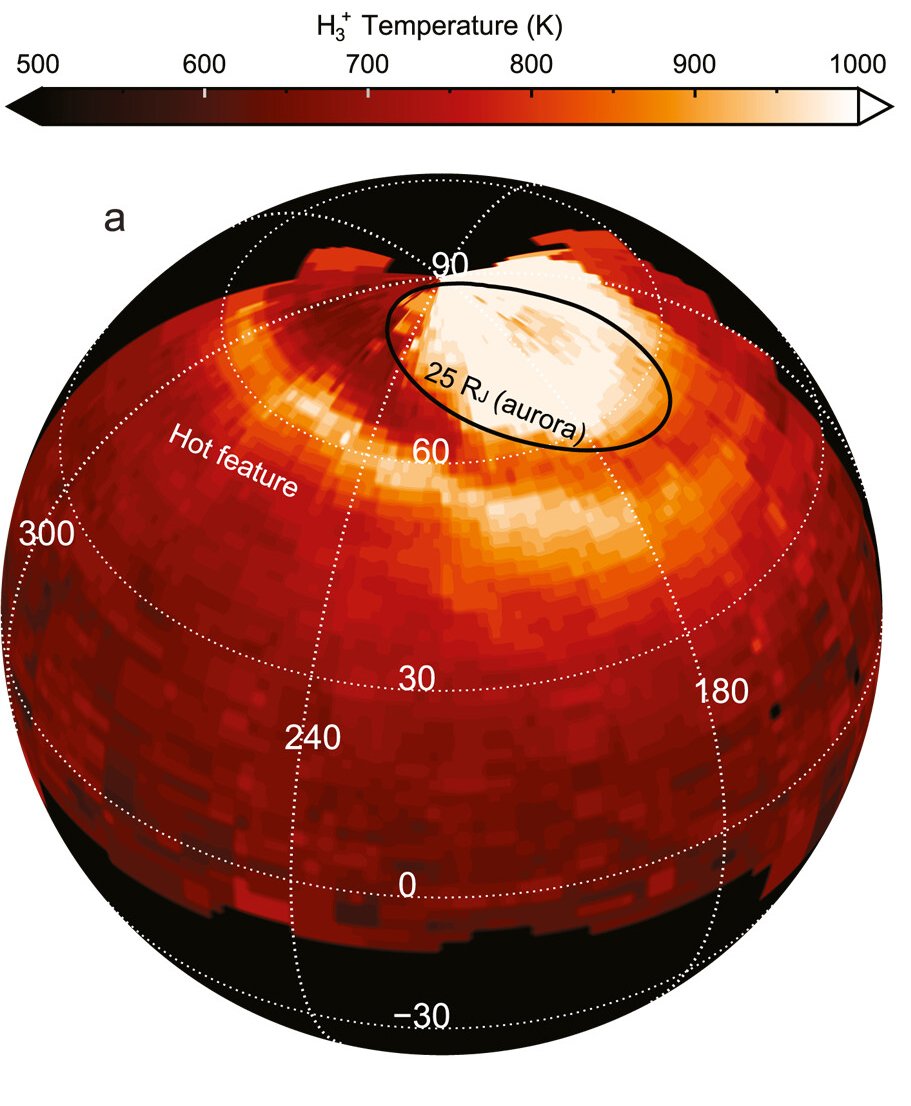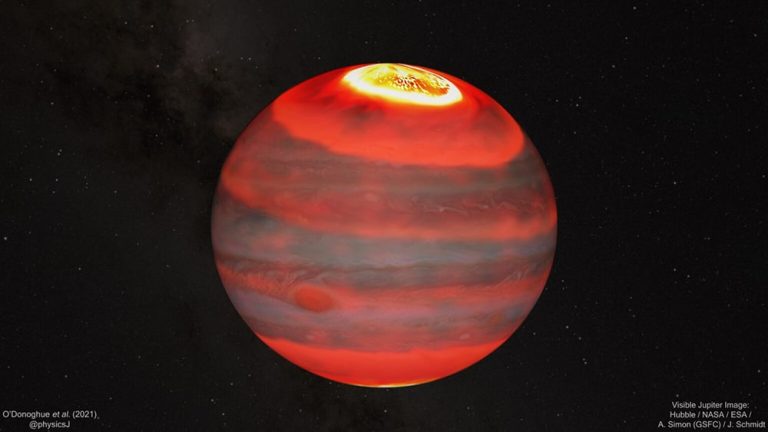The Solar Wind Crashes Into Jupiter a Few Times Every Month: Shocking Space Weather Explained
Solar wind interactions with Jupiter’s vast magnetosphere create extreme heating events and dramatic auroral displays, providing new insights into space weather phenomena and planetary behavior.
Summary
- Solar wind bursts compress Jupiter’s magnetosphere, triggering high-temperature hot spots.
- Repeated impacts occur several times each month on the giant planet.
- Observations combine data from the Juno spacecraft and Earth-based telescopes.
- Increased auroral energy is redirected from the poles toward the equator.
- Comparative studies suggest similar impacts may affect other gas giants.
- Models developed from these studies will help forecast solar storm impacts.
- New research improves our understanding of planetary magnetospheres.
- The phenomena challenge previous assumptions about Jupiter’s atmospheric stability.
- Insights gained are applicable for protecting Earth-based technologies.
- Scientific collaboration paves the way for future space weather research.
Introduction
The solar system is a dynamic place with many surprising interactions. One such interaction involves the solar wind—a constant stream of charged particles from the Sun—and Jupiter, the largest planet in our neighborhood. Recent research reveals that the solar wind crashes into Jupiter’s magnetic field multiple times every month. These high-energy impacts not only raise the temperature of certain regions on Jupiter but also trigger exceptional auroral displays. This article explains how these events occur, the science behind them, and what they mean for our understanding of space weather.
The Dynamics of Solar Wind and Jupiter
Jupiter is known for its enormous size and strong magnetic field. When the solar wind hits Jupiter, it compresses the planet’s magnetosphere, causing dramatic changes in its atmosphere. During these collisions, charged particles slam into the magnetic shield, creating hot spots with temperatures that can exceed 500°C. Such events challenge our previous ideas about the uniformity of Jupiter’s atmospheric temperature and show that the planet is far more dynamic than once believed.
Advanced instruments and spacecraft have made it possible to observe these interactions in detail. The data collected from missions such as the Juno spacecraft and observatories like Keck Observatory have been critical in identifying and understanding the impact of solar wind on Jupiter’s atmosphere.

Observations and Data Collection
Scientists have turned to both space-based and ground-based observations to gather extensive data on Jupiter’s space weather. For instance, telescopic images capture Jupiter’s vibrant aurorae, while readings from the Juno spacecraft provide clues about magnetic field compressions and temperature spikes. A detailed study published in a scientific journal noted that these temperature surges occur as a direct result of solar wind impacts, challenging previous atmospheric models.
| Parameter | Jupiter | Saturn |
|---|---|---|
| Diameter | 139,820 km | 116,460 km |
| Magnetosphere Size | Extremely vast | Large, yet smaller |
| Solar Impact Rate | Several times per month | Rare, occasional impacts |
The extensive dataset reveals that the impact of the solar wind on Jupiter is not a rare event, but a recurring phenomenon that forces charged particles deep into the planet’s upper atmosphere. These particles collide with atmospheric atoms and molecules, energizing them to create brilliant auroral light shows that extend far beyond the polar regions.
Scientific Insights and Theories
The recurring nature of these solar wind impacts has led scientists to develop new theories about the behavior of Jupiter’s magnetic environment. One leading idea proposes that the solar wind compresses the magnetosphere so intensely that it intensifies local auroral heating. Normally, Jupiter’s poles are warmer because of the magnetic field concentration. However, when the solar wind impacts, the energy disperses more widely across the atmosphere, warming regions closer to the equator.
Understanding Magnetospheres
The study of magnetospheres is not just about understanding planetary conditions but also about preparing for the impact of space weather closer to home. A magnetosphere is a protective magnetic bubble that surrounds a planet. In the case of Earth, our magnetosphere deflects harmful charged particles from the solar wind. However, when the solar wind is strong enough, even Earth’s protective shield can be temporarily overwhelmed—causing phenomena such as auroras, satellite disruptions, and even power grid failures.
Jupiter’s magnetosphere, being much larger, provides a unique perspective. Its reactions to solar wind impacts are more pronounced and varied, offering scientists a grand natural laboratory to study the physical processes involved in magnetic field interactions. Moreover, the study of Jupiter helps refine the models used to predict space weather events that affect all the planets, including our own.
Comparative Planetary Analysis
Comparing Jupiter’s responses to those of other planets deepens our understanding of space weather. Although Saturn and Uranus also experience solar wind impacts, the extent and frequency differ. Saturn’s magnetosphere, for instance, receives solar wind hits less frequently and shows different auroral characteristics compared to Jupiter. Detailed comparisons, such as the one in the table above, highlight these differences and suggest that each planet responds uniquely based on its size, magnetic strength, and atmospheric composition.
| Observation | Earth’s Response | Jupiter’s Response |
|---|---|---|
| Temperature Change | Mild to moderate fluctuations | Extreme hot spot formation |
| Auroral Activity | Displays as northern/southern lights | Enormous and extended aurorae |
| Impact on Technology | Satellite and grid disruptions | Valuable data for model improvements |
Studying these differences not only enhances our scientific knowledge but also assists in preparing space agencies for future missions. The data gathered from Jupiter, in particular, enriches our predictive models and helps inform the design of spacecraft that must withstand intense solar activities.
Solar weather events affect more than just the planets; they have real consequences for human technology and safety. On Earth, intense solar storms are known to interfere with satellite communications, disrupt power supplies, and affect navigation systems. The insights gleaned from Jupiter’s solar wind impacts are leading to improved forecasting and mitigation strategies. With better predictions, engineers can design more resilient systems to protect satellites and power grids from unexpected solar events.

Furthermore, astronauts venturing beyond Earth’s protective atmosphere are highly vulnerable to solar radiation. Learning how space weather influences planetary environments helps in planning safer missions. Researchers are working on advanced warning systems and protective measures that could one day be used to safeguard human explorers on missions to Mars and other destinations.
The field of space weather research is rapidly evolving. New missions are planned to continuously monitor the solar wind and its impacts on various planets. Ongoing observations combined with advanced simulation models promise to revolutionize our understanding of the interactions between solar wind and planetary magnetospheres. This research not only benefits scientists but also has practical applications for improving space travel and protecting Earth’s technological infrastructure.
Collaborative efforts between international space agencies and research institutions are essential to drive progress forward. As the technology improves, we can expect more detailed and frequent data collection, which will ultimately lead to more precise forecasting models. With every new discovery, we get closer to solving the mystery of how solar wind affects not just Jupiter, but all the bodies in our solar system.
Facts about Jupiter and Solar Wind
Jupiter is not only the largest planet in our solar system, but it also spins rapidly—completing one rotation in about 10 hours. This rapid rotation contributes to the strong magnetic field that defines the planet. The solar wind, though invisible to the naked eye, is a mighty force that continually shapes the environment of every planet it touches. Despite its distance from the Sun, Jupiter experiences these intense bursts of energy, making it a key focus for space weather studies.
References
For additional details on these fascinating phenomena, please refer to the following resources:

